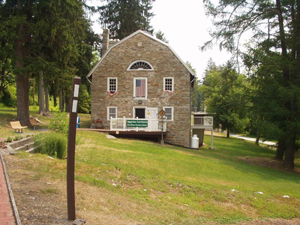
GARDNERS, Pa. – Funding raised during its second season of operation will permit the Appalachian Trail Museum to move forward with completion of its final phases of construction.
“Our goal all along has been to convert the entire building in which we are so fortunate to be located into exhibits and education areas,” said Larry Luxenberg, president of the Appalachian Trail Museum Society, and founder of the museum.
“We can now do that thanks to the generosity of individual donors and grants from the Quimby Family Foundation in Portland, Maine, the Hershey Co. in Hershey, Pa., and the South Mountain Partnership and Pennsylvania Department of Conservation and Natural Resources. A key component for us moving forward with the next phases was meeting a $50,000 challenge grant, and that has been achieved, ” said Luxenberg.
The Appalachian Trail Museum is completing its second season of being open, June from through October in 2010 and April through October in 2011. Since its opening the museum has attracted more than 15,000 visitors, national media attention and acclaim and has become one of the top tourist attractions in Cumberland County.
Luxenberg said the 200-year-old stone grist mill that houses the museum has been restored mostly by volunteers. In the first phase, the museum showcases and honors the legendary hikers who made the idea for a footpath from Maine to Georgia a reality. The trail today is 2,181 miles long and crosses 14 states. It passes by the entrance of the Appalachian Trail Museum, and its midway point is 2 miles south of the museum.
Among the trail pioneers honored now with exhibits are Benton MacKaye who is credited with conceptualizing the Appalachian Trail, and Myron Avery who is credited with spearheading construction of the trail that was completed in 1937. One of the hiker shelters built by York, Pa., native Earl Shaffer is the museum’s first feature exhibit. In 1948, Shaffer was the first person to hike the trail end to end. Other thru-hikers who are featured are Gene Espy who, in 1951, became the second person to thru-hike the trail, Grandma Gatewood, who, in 1955 at the age of 67, became the first solo woman thru-hiker and later became the first person to hike the trail more than once, and Ed Garvey of Falls Church, Va, who popularized long distance backpacking in the 1970s.
The museum also is home for the Appalachian Trail Hall of Fame, which inducted its first six members earlier this year.
“Exhibits in the next phases will continue to portray not only the history of the Appalachian Trail but also the essence of the physical, intellectual, emotional and spiritual human experience of the Appalachian environment and the culture of hiking,” Luxenberg said. “Among the exhibits in the second phase will be hiking and trail maintenance artifacts. We hope to have these in place for the beginning of our third season next year.”
The museum is adjacent to the National Historic District of Pine Grove Furnace State Park and the Pine Grove General Store. It also is near the Ironmasters Mansion (hostel). Both the store and the hostel are popular stops for Appalachian Trail thru-hikers. The museum is open from noon to 4 p.m. daily from Memorial Day to Labor Day and on weekends from noon to 4 p.m. from now to Oct. 31 plus Columbus Day.
Inquiries about becoming a museum volunteer or a sponsor or about making a donation may be made at the museum’s website, www.atmuseum.org, and info@atmuseum.org.

